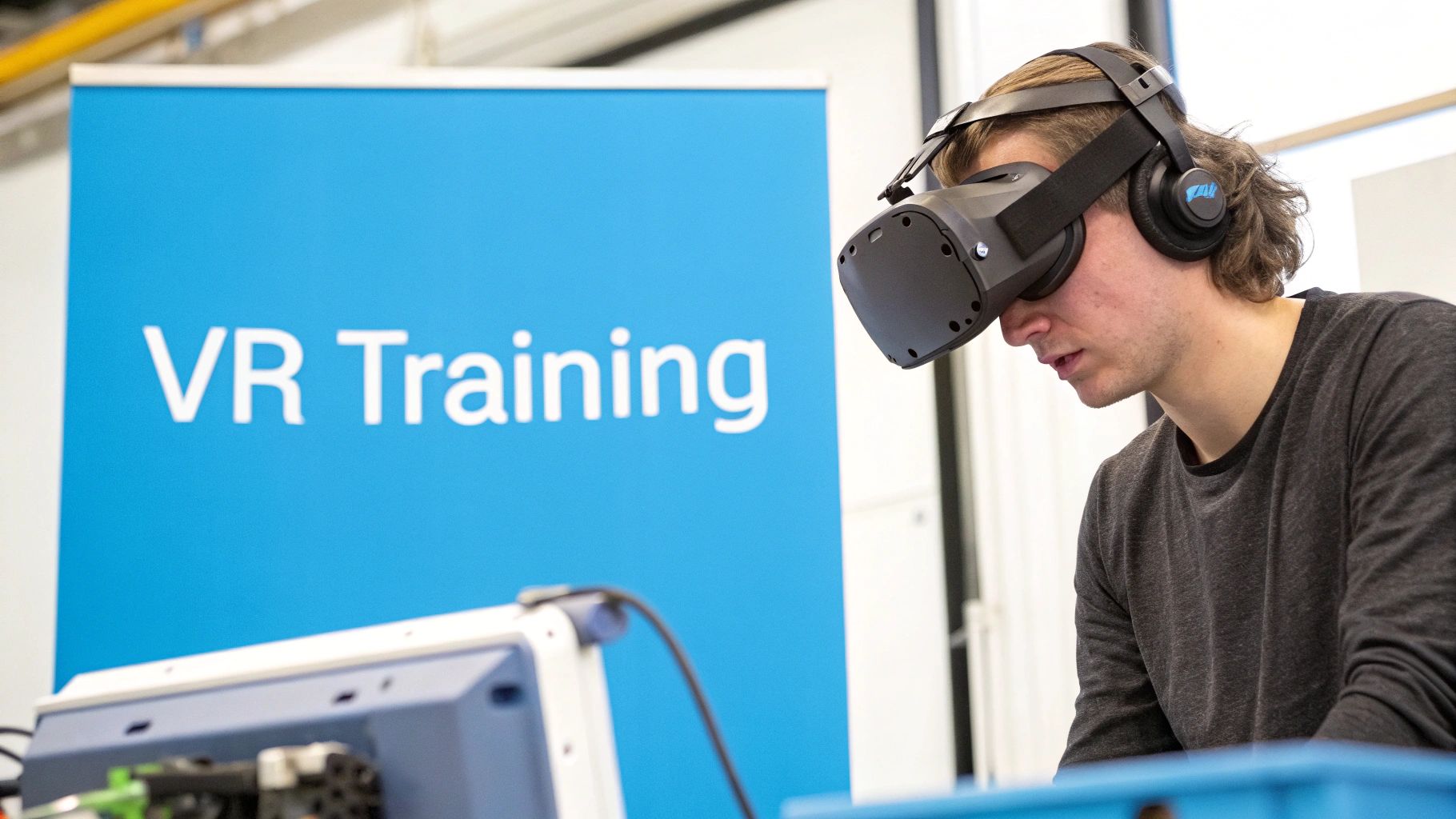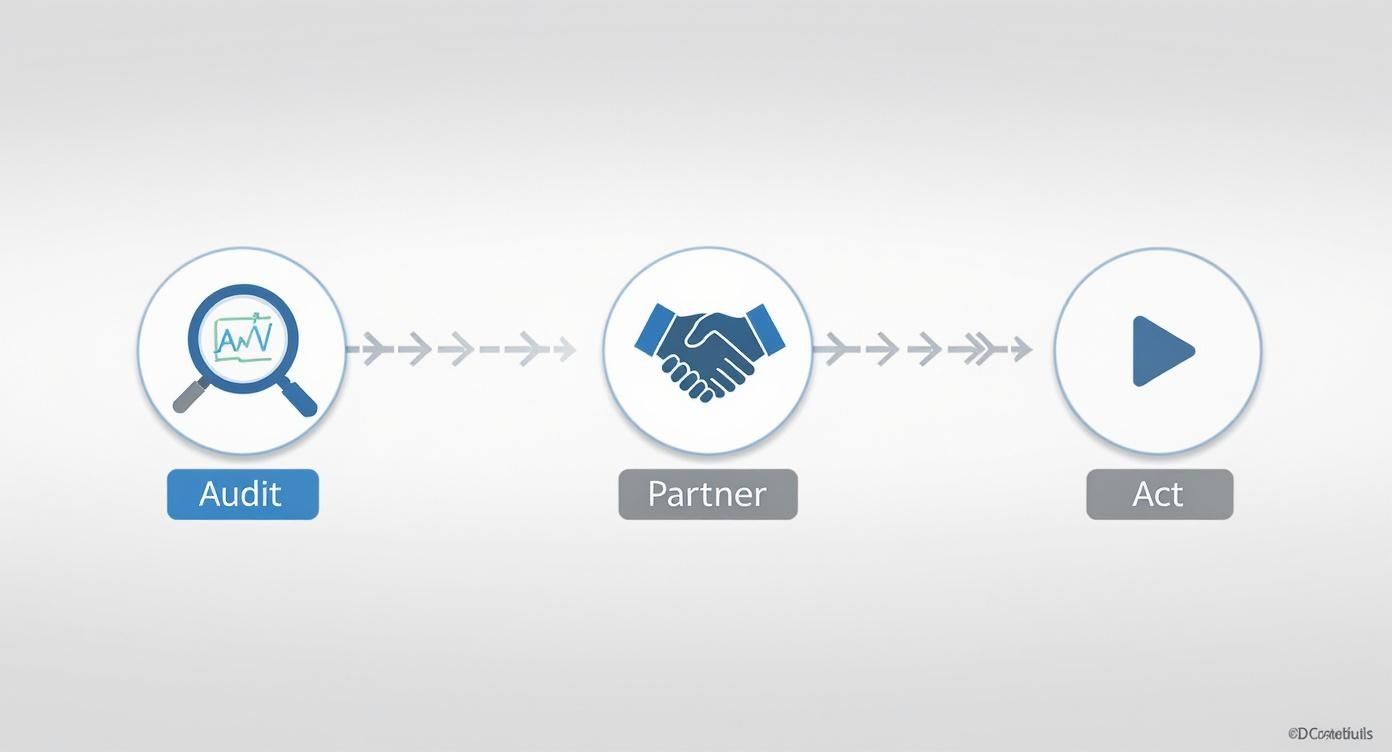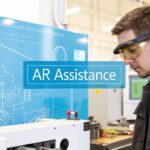Improve Manufacturing Process Efficiency with AR & VR: A Practical Guide
Relying solely on traditional manufacturing methods can limit operational efficiency. The industry is making a decisive shift toward smarter, technology-driven strategies for good reason. Integrating immersive tools like Augmented Reality (AR) and Virtual Reality (VR) is no longer a futuristic concept—it's a practical strategy to enhance training, perfect assembly processes, and reduce costly errors on the production line.
A New Blueprint for Manufacturing
The manufacturing landscape is evolving rapidly, demanding more agile and intelligent operational methods. Immersive technologies have moved from development labs to the factory floor, becoming essential tools for organizations seeking a competitive advantage.
This guide focuses on real-world applications that deliver tangible results. We will outline the practical, actionable steps for integrating AR and VR into your operations to achieve significant gains in:
- Productivity
- Safety
- Quality control
Consider this your roadmap to building a more resilient and efficient operation. You can learn more about the growing role of new technologies in manufacturing and see how they are actively reshaping the industry today.
Laying the Groundwork for Immersive Technology
Before deploying any new technology, a strategic foundation is essential. Successfully implementing AR/VR in a manufacturing setting is less about the technology itself and more about a well-defined, upfront strategy. The process should begin with a thorough needs analysis to identify specific operational challenges.
Are assembly errors impacting your budget and timelines? Is maintenance downtime reducing productivity? Pinpoint the specific bottlenecks that require the most immediate attention.
Once you have identified a target area, you can build a business case that demonstrates tangible ROI. The objective is to position this technology not as an experimental tool, but as a core component of a smart factory initiative. The data supports this approach: manufacturers adopting such technologies often see production output increase by 10% to 20%. For a deeper analysis, the National Association of Manufacturers provides a detailed overview of the key manufacturing trends driving this change.
This early-stage planning is non-negotiable. It requires an infrastructure review and collaboration between key stakeholders from IT and operations from the outset. This foundational work ensures your immersive technology deployment delivers value and helps avoid common implementation pitfalls.
Accelerating Skills With Virtual Reality Training

Imagine training new employees on complex machinery without risking injury or expensive equipment damage. This is the practical benefit that Virtual Reality (VR) delivers to modern manufacturing.
With VR, you can create a precise digital twin of your assembly line or simulate rare but critical emergency scenarios. It provides a controlled environment where mistakes become learning opportunities, not costly setbacks. This approach makes training safer, repeatable, and more engaging.
This shift toward immersive learning is a key component of the Industry 4.0 evolution. The market for these technologies is projected to grow at a CAGR of over 20% through 2032, driven by the demand for solutions that enhance precision and reduce human error. You can explore more insights on the rise of manufacturing automation and its impact on operational speed.
A significant benefit is the ability to train an entire workforce on new processes before new equipment is even installed on the factory floor. By developing robust VR training programs, you are not just educating employees—you are proactively building a more skilled, confident, and safer team.
Comparing Traditional vs. VR-Based Manufacturing Training
When traditional training methods are compared with a modern VR approach, the advantages become clear. The methodology shifts from passive observation to active, hands-on learning.
| Metric | Traditional Training Methods | VR-Based Training |
|---|---|---|
| Safety | Involves real equipment, posing risks of injury and damage. | 100% risk-free environment. Mistakes have no real-world consequences. |
| Knowledge Retention | Typically lower; relies on memorization and observation. | Significantly higher; learning by doing creates strong muscle memory. |
| Cost-Effectiveness | High costs from machine downtime, material waste, and instructor time. | Lower long-term costs. No production stoppage or wasted materials. |
| Accessibility & Repetition | Limited by equipment availability and instructor schedules. | On-demand access. Trainees can practice complex tasks repeatedly. |
| Realism | Limited to available scenarios; rare emergencies are hard to replicate. | Can simulate any scenario, including high-stakes emergencies. |
| Performance Tracking | Often subjective and based on instructor observation. | Detailed, data-driven analytics on user performance and weak points. |
Ultimately, VR transforms training from a necessary expense into a strategic advantage, creating a workforce that's better prepared, more efficient, and far more adaptable.
Augmenting Operations with Augmented Reality
While VR creates a fully simulated environment, Augmented Reality (AR) enhances efficiency by overlaying critical data onto the real-world workspace. This fundamentally changes how tasks are performed on the factory floor by providing technicians with the exact information they need, directly in their line of sight.
For example, an assembly worker can view a complex piece of machinery while digital schematics are overlaid directly onto the physical component. Each step is guided with precision, which not only accelerates the process but also reduces minor errors that lead to significant time and material costs.
AR's applications extend beyond assembly. It is a transformative tool for maintenance. Through remote assistance, an expert in another location can see exactly what a field technician is viewing. They can provide live, step-by-step instructions to resolve an issue, dramatically reducing equipment downtime.
This capability becomes even more powerful when integrated with AI. According to a report from Columbus Global, 88% of UK manufacturers are already investing in AI. The logical next step is to blend these intelligent systems with AR for enhanced operational insight.
To learn more about AI's growing influence, you can review this analysis on AI's impact on manufacturing trends. For a closer look at how AR transforms maintenance work, we have compiled a detailed guide on augmented reality for maintenance.
Proving It Works: Measuring Success and Scaling Your Initiative
Deploying AR/VR tools is only the first phase. The true value is realized when you measure their impact and demonstrate tangible improvements on the factory floor.
To truly improve manufacturing process efficiency, you must focus on quantitative results. This involves tracking key performance indicators (KPIs) such as reduced error rates, accelerated onboarding for new hires, and improved first-pass yield. This data-driven approach allows you to build a solid business case, demonstrate clear ROI to stakeholders, and secure support for future initiatives.
Know Your Starting Point
Before you can measure improvement, you must establish a baseline. That is why establishing baseline metrics for continuous improvement is an essential first step. Document your error rates before AR implementation. Measure the time required to train a new technician using conventional methods. These initial numbers are crucial for comparison.
Once you have your baseline, you can begin scaling with a structured methodology.
- Start Small: Begin with a focused pilot project. Choose one specific workflow or a single production line to test the technology.
- Gather Feedback: Collect detailed feedback from the technicians and supervisors using the technology. Their insights on usability and effectiveness are invaluable.
- Expand Strategically: Use the data and feedback from your pilot to inform a strategic expansion to other lines, departments, or facilities.
This phased approach mitigates risk and ensures that each stage of the expansion is built on proven success.
For a comprehensive guide on tracking the right metrics, our article on how to measure training effectiveness provides valuable frameworks you can implement immediately. This methodical process is the key to sustainable growth and maximizing the operational value of your investment.
Time To Make Your Move Toward a Smarter Factory
We have outlined a complete roadmap: from setting a solid strategy and overhauling training with VR to deploying AR for enhanced precision on the factory floor. We have also covered how to measure results to scale your initiatives with confidence.
Integrating these immersive technologies is no longer optional—it is a core component of future-proofing your manufacturing operations.
The final takeaway is clear: it is time to get started. The journey begins now.
The path from concept to competitive advantage begins with a single, decisive action. The optimal moment is now. Take the first step today toward building a more resilient and innovative manufacturing future. The potential gains in efficiency are too significant to ignore, and you can be certain your competition is not standing still.
Frequently Asked Questions
When teams begin exploring how to improve manufacturing process workflows with immersive technology, many practical questions arise concerning costs, integration, and user adoption. For more general platform information, you can also review our general FAQs.
However, one of the most common initial questions is, "Where do we begin?"
This infographic breaks the process down into a clear, effective workflow for taking those first steps.

As shown, the flow maps out the key phases—from auditing your operational needs to identifying the right partners and, finally, taking decisive action. It is about following a structured, low-risk path to ensure a successful implementation.
Ready to take the first step and see how AR/VR can reshape your operations? Contact AIDAR Solutions today, and let's build a smarter factory together. Learn more at https://aidarsolutions.com.

